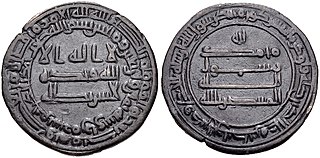 W
WAbu Musa Muhammad ibn Harun al-Rashid, better known by his regnal name of al-Amin, was the sixth Abbasid Caliph. He succeeded his father, Harun al-Rashid, in 809 and ruled until he was deposed and killed in 813, during the civil war with his half-brother, al-Ma'mun.
 W
WHarun al-Rashid (; Arabic: هَارُون الرَشِيد Hārūn Ar-Rašīd; "Aaron the Orthodox" or "Aaron the Rightly-Guided", 17 March 763 or February 766 – 24 March 809 was the fifth Abbasid Caliph. His birth date is debated, with various sources giving dates from 763 to 766. His epithet "al-Rashid" translates to "the Orthodox", "the Just", "the Upright", or "the Rightly-Guided". Al-Rashid ruled from 786 to 809, during the peak of the Islamic Golden Age. He established the legendary library Bayt al-Hikma in Baghdad in present-day Iraq, and during his rule Baghdad began to flourish as a center of knowledge, culture and trade. During his rule, the family of Barmakids, which played a deciding role in establishing the Abbasid Caliphate, declined gradually. In 796, he moved his court and government to Raqqa in present-day Syria.
 W
WAbu al-Abbas Abdallah ibn Harun al-Rashid, better known by his regnal name al-Ma'mun, was the seventh Abbasid caliph, who reigned from 813 until his death in 833. He succeeded his half-brother al-Amin after a civil war, during which the cohesion of the Abbasid Caliphate was weakened by rebellions and the rise of local strongmen; much of his reign was consumed in pacification campaigns. Well educated and with a considerable interest in scholarship, al-Ma'mun promoted the Translation Movement, the flowering of learning and the sciences in Baghdad, and the publishing of al-Khwarizmi's book now known as "Algebra". He is also known for supporting the doctrine of Mu'tazilism and for imprisoning Imam Ahmad ibn Hanbal, the rise of religious persecution (mihna), and for the resumption of large-scale warfare with the Byzantine Empire.
 W
WAbu'l-Abbas Ahmad ibn Talha al-Muwaffaq, better known by his regnal name al-Mu'tadid bi-llah, was the Caliph of the Abbasid Caliphate from 892 until his death in 902.
 W
WAbū Isḥāq Muḥammad ibn Hārūn al-Rashīd, better known by his regnal name al-Muʿtaṣim biʾllāh, was the eighth Abbasid caliph, ruling from 833 until his death in 842. A younger son of Caliph Harun al-Rashid, he rose to prominence through his formation of a private army composed predominantly of Turkish slave-soldiers (ghilmān). This proved useful to his half-brother, Caliph al-Ma'mun, who employed al-Mu'tasim and his Turkish guard to counterbalance other powerful interest groups in the state, as well as employing them in campaigns against rebels and the Byzantine Empire. When al-Ma'mun died unexpectedly on campaign in August 833, al-Mu'tasim was thus well placed to succeed him, overriding the claims of al-Ma'mun's son al-Abbas.
 W
WAbū ʿAbd Allāh Muḥammad ibn Jaʿfar, better known by his regnal title al-Muʿtazz bi-ʾllāh was the Abbasid caliph from 866 to 869, during a period of extreme internal instability within the Abbasid Caliphate, known as the "Anarchy at Samarra".
 W
WAbū Isḥāq Muḥammad ibn al-Wāṯiq, better known by his regnal name al-Muhtadī bi-'llāh, was the Caliph of the Abbasid Caliphate from July 869 to June 870, during the "Anarchy at Samarra".
 W
WAbu Ja'far Muhammad, better known by his regnal title al-Muntasir bi-llah was the Caliph of the Abbasid Caliphate from 861 to 862, during the "Anarchy at Samarra". He was preceded by al-Mutawakkil and succeeded by al-Musta'in.
 W
WAl-Musta'in was the Abbasid Caliph from 862 to 866, during the "Anarchy at Samarra". After the death of previous Caliph, al-Muntasir, the Turkic military leaders held a council to select his successor. They were not willing to have al-Mu'tazz or his brothers; so they elected Ahmad ibn Muhammad أحمد بن محمد, a grandson of al-Mu'tasim, who took the regnal name al-Mustaʿin bi-llah.
 W
WAbu’l-ʿAbbās Aḥmad ibn Jaʿfar, better known by his regnal name al-Muʿtamid ʿalā ’llāh, was the Caliph of the Abbasid Caliphate from 870 to 892. His reign marks the end of the "Anarchy at Samarra" and the start of the Abbasid restoration, but he was a largely a ruler in name only. Power was held by his brother al-Muwaffaq, who held the loyalty of the military. Al-Mu'tamid's authority was circumscribed further after a failed attempt to flee to the domains controlled by Ahmad ibn Tulun in late 882, and he was placed under house arrest by his brother. In 891, when al-Muwaffaq died, loyalists attempted to restore power to the Caliph, but were quickly overcome by al-Muwaffaq's son al-Mu'tadid, who assumed his father's powers. When al-Mu'tamid died in 892, al-Mu'tadid succeeded him as caliph.
 W
WAbu al-Faḍl Jaʽfar ibn Muḥammad al-Muʽtaṣim billāh, better known by his regnal name al-Mutawakkil ʽalà Allāh was the 10th Abbasid caliph, under whose reign the Abbasid Empire reached its territorial height. He succeeded his brother al-Wathiq. Deeply religious, he is known as the caliph who ended the Mihna, released Ahmad ibn Hanbal, and discarded the Muʿtazila, but he has been also subject of criticism for being a tough ruler towards the non-Muslim citizens.
 W
WAbū Jaʿfar Hārūn ibn Muḥammad, better known by his regnal name al-Wāthiq Bi’llāh, was an Abbasid caliph who reigned from 842 until 847 AD. Al-Wathiq is relatively obscure both as a ruler and as a person, and his reign is largely considered a continuation of his father's. The chief events of his reign were the suppression of a Bedouin rebellion in the Hejaz in 845 and an abortive uprising in Baghdad in 846. The conflict with the Byzantine Empire continued, and the Abbasids even scored a significant victory at Mauropotamos, but after a truce in 845, warfare ceased for several years.